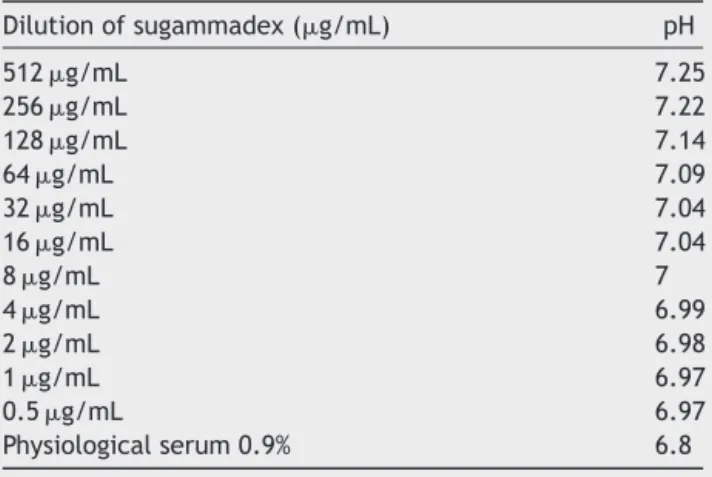RevBrasAnestesiol.2014;64(2):105---108
REVISTA
BRASILEIRA
DE
ANESTESIOLOGIA
OfficialPublicationoftheBrazilianSocietyofAnesthesiologywww.sba.com.br
SCIENTIFIC
ARTICLE
In
vitro
evaluation
of
antimicrobial
features
of
sugammadex
夽
Volkan
Hanci
a,∗,
Ahmet
Vural
b,
Sevgi
Yılmaz
Hanci
c,
Hasan
Ali
Kiraz
d,
Dilek
Ömür
d,
Ahmet
Ünver
baDepartmentofAnesthesiologyandReanimation,MedicalFacultyofDokuzEylülUniversity, ˙Izmir,Turkey bDepartmentofMicrobiology,MedicalFacultyofC¸anakkaleOnsekizMartUniversity,C¸anakkale,Turkey cClinicofMicrobiology,C¸anakkaleStateHospital,C¸anakkale,Turkey
dDepartmentofAnesthesiologyandReanimation,MedicalFacultyofC¸anakkaleOnsekizMartUniversity,C¸anakkale,Turkey
Received10September2012;accepted10June2013 Availableonline11October2013
KEYWORDS
Sugammadex; Antimicrobialeffect;
S.aureus;
E.fecalis;
E.coli;
P.aeruginosa
Abstract
Background: Drugs administered byintravenous routesmay be contaminatedduring several
stages ofproductionorpreparation. Sugammadex isamodified gammacyclodextrin.While
researchintotheantibacterial effectsofvarietiesofcyclodextrin isavailable,thereareno studiesfocusingontheantibacterialeffectsofsugammadex.Thisstudyinvestigatestheinvitro antimicrobialactivityofsugammadex.
Materialsandmethods: The invitroantimicrobial activityofsugammadex was investigated
using thebroth microdilutionmethod. The pH ofthetest solution was determinedusing a
pHmeter.ThetestmicroorganismsincludedStaphylococcusaureusATCC29213,Enterococcus
fecalisATCC29212,EscherichiacoliATCC25922andPseudomonasaeruginosaATCC27853.In
the secondphaseofthestudy 100mg/mLsugammadex(50g)was contaminatedwithtest
microorganisms(50g),includingS.aureusATCC29213,E.fecalisATCC29212,E.coliATCC
25922andP.aeruginosaATCC27853,lefttoincubatefor24handthenthebacterialproduction
insugammadexwasevaluated.
Results:ThepHofthetestsolutionsrangedbetween7.25and6.97.Usingthemicrodilution method,sugammadexhadnoantibacterialeffectonS.aureus,E.fecalis,E.coliandP. aerugin-osaatanyconcentration.Inthesecondphaseofthestudybacterialproductionwasobserved after24hin100mg/mLsugammadexcontaminatedwiththetestmicroorganismsS.aureus,E. fecalis,E.coliandP.aeruginosa.
Conclusions: Sugammadexhadnoantimicrobialeffectonthetestmicroorganisms,S.aureus,E. fecalis,E.coliandP.aeruginosa.Careshouldbetakenthatsterileconditionsaremaintainedin
thepreparationofsugammadex;thatthesamesugammadexpreparationnotbeusedformore
thanonepatient;andthatstorageconditionsareadheredtoaftersugammadexisputintothe injector.
© 2013SociedadeBrasileirade Anestesiologia.Publishedby ElsevierEditoraLtda.Allrights reserved.
夽 Apartofthismanuscriptwaspresentedasaposterpresentationatthe46thAnnualTARKCongress,Cyprus,7---11November2012.
∗Correspondingauthor.
E-mail:vhanci@gmail.com(V.Hanci).
0104-0014/$–seefrontmatter©2013SociedadeBrasileiradeAnestesiologia.PublishedbyElsevierEditoraLtda.Allrightsreserved.
106 V.Hancietal.
Introduction
Some anesthetic agents such as propofol are known to
support the growth of microorganisms,1---5 while other
anesthetic agents such as morphine sulphate, thiopental
sodium, fentanyl citrate, dexmedetomidine and
midazo-laminhibitmicrobial growth.3---7 Anestheticagentsmaybe
contaminated by microorganisms at various stages during
preparationforuse.2Itisimportantforthisreasonthatthe
antibacterialproperties,ortheabilitytoenhancebacterial
production,ofanestheticagentsinacontaminatedsituation
beknown.8
Sugammadex is a modified gamma cyclodextrin.9---11
Cyclodextrins are water soluble cyclic oligosaccharides
with a lipophilic core. Sugammadex has quickly found a
placeinclinicaluseasaselectiveneuromuscularblockade
reverser.9---11 Sugammadex quickly encapsulates steroidal
neuromuscularblockers, increasing the amount of
encap-sulated steroidal neuromuscular blockers in plasma and
separating the blockers from the nicotinic acetylcholine
receptors.9---11
Cyclodextrins are molecules that are often used in
the food and pharmaceutical industries. They are
com-monlyusedtoconvertlipophilicmedicationstohydrophilic
forms.Otherapplicationsofcyclodextrinsincludethefield
of microbiology. Some cyclodextrins, such as
dimethyl-b-cyclodextrin, have been used to increase production of
Helicobacter pylori,12 while others, like
hydroxypropyl-b-cyclodextrin, have been reported to prevent bacterial
production when used to coat vascular prostheses.13
Howevertherearenostudiesevaluatingtheeffectof
sug-ammadex,amodified gammacyclodextrinmoleculelately
beingusedinanesthesiology,onbacterialproduction.
Theaimofthisstudywastoevaluatetheantimicrobial
effectsofsugammadexonthetestmicroorganisms.Thetest
microorganismschosen wereStaphylococcusaureus
Amer-ican Type Culture Collection (ATCC) 29213, Enterococcus
fecalisATCC29212,EscherichiacoliATCC25922and Pseu-domonasaeruginosaATCC27853.
Materials
and
methods
Theantibacterialactivityofsugammadexwasinvestigated
usingthebrothmicrodilutionmethodaccordingtothe
pro-ceduresoutlinedbythe ClinicalandLaboratoryStandards
Institute(CLSI).14
Briefly, sugammadex was diluted with 0.9% sterile
saline to final concentrations of 512g/mL, 256g/mL,
128g/mL, 64g/mL, 32g/mL, 16g/mL, 8g/mL,
4g/mL,2g/mL,1g/mLand0.5g/mL.Foreach
neu-romuscularblockingdrug,thepHvaluesofallthedilutions
weredeterminedwithapHmeter (SartoriuspHMeter
PB-11).S. aureus ATCC29213, E. fecalisATCC29212, E.coli
ATCC25922andP.aeruginosaATCC27853wereusedas
con-trolmicroorganisms.The bacteria(5×105 colony-forming
unitspermilliliter;(CFU/mL)),MHB(Mueller---Hiltonbroth)
andthesugammadexinthe specifiedconcentrationswere
incubated in wells on microplates at 35◦C for 20h. The
minimal inhibitory concentrations (MIC) were determined
by observing the lowest concentration of the agent that
Table1 ThepHvaluesoftesteddilutionsofsugammadex.
Dilutionofsugammadex(g/mL) pH
512g/mL 7.25
256g/mL 7.22
128g/mL 7.14
64g/mL 7.09
32g/mL 7.04
16g/mL 7.04
8g/mL 7
4g/mL 6.99
2g/mL 6.98
1g/mL 6.97
0.5g/mL 6.97
Physiologicalserum0.9% 6.8
inhibitedvisiblegrowthofthebacterium.Hazeorturbidity inthewellswasanindicatorofbacterialgrowth.
Inthesecondstageofthestudy100mg/mLsugammadex wascontaminatedwiththetestorganisms,S.aureusATCC 29213,E.fecalisATCC29212,E.coliATCC25922andP. aeru-ginosaATCC27853.Bacteria,50L(5×105colony-forming
units per milliliter; (CFU/mL)), and 50L sugammadex
(100mg/mL)wereincubatedat35◦Cfor24h.After24hthe
bacterialproductioninthesugammadexwasevaluated.
Results
Using the microdilution technique, sugammadex had no antibacterialeffectonS. aureus,E.fecalis,E.coliandP. aeruginosaatanyconcentration.
In the second part of the study, after 24h incubation 100mg/mL sugammadexcontaminated with S. aureus, E. fecalis, E. coli and P. aeruginosa, bacterial growth was observed.
The pH of thetest solutions ranged between 7.25 and 6.97.ThepHvaluesarelistedinTable1.
Discussion
In this study, we found that sugammadex does not have
antimicrobialpropertieswithregardtothetestorganisms,
S.aureus,E.fecalis,E.coliandP.Aeruginosa.
Drugsmanufacturedfor intravenoususe shouldbe
pre-pared and administered in sterile conditions. Infectious
microorganismscanbeintroducedintothepatientthrough
contaminatedcontainers,rubber diaphragms,needlesand
infusionsets.
Anestheticagentsmaybecontaminatedby
microorgan-ismsduringpreparation.Forthisreason,theantimicrobial
effectsoftheusedagentsareimportant.8Itisknownthat
propofolsupportsthegrowthofmicroorganisms.2---4,7,8,15---18
Ontheotherhand,morphinesulphate,thiopentalsodium,
fentanyl citrate, dexmedetomidine, atracurium,
rocuro-niumandmidazolamhaveantimicrobialeffects.3,5---8
Sugammadex is a modified gamma cyclodextrin.9---11
Cyclodextrins are molecules that are often used in the
food and pharmaceutical industries. They are commonly
usedtoconvertlipophilicmedicationstohydrophilicforms.
Antimicrobialfeaturesofsugammadex 107
alipophiliccore.Otherapplicationsofcyclodextrinsinclude
the field of microbiology. Some cyclodextrins, such as
dimethyl-b-cyclodextrin, have been used to increase
pro-ductionofH.pylori.12Whenaddedtoagargelscyclodextrins
suchasalpha-andbeta-cyclodextrin/hexadecaneare
suit-able foodbeds for the growth of microorganisms such as
CandidalipolyticaandC.tropicalis.19 Researchhasshown
that cyclodextrin molecules, such as beta-cyclodextrin,
when added to liquid cultures neutralize potential toxic
combinations and increase the growth of microorganisms
such as H. pylori.20---22 Solid cultures including modified
cyclodextrins have been used for selective isolation of
microorganismssuchasBordetellapertussis.23---26
However other cyclodextrins, such as
hydroxypropyl-b-cyclodextrin, have been reported to prevent bacterial
production when used to coat vascular prostheses.13
Previous studies have reported methyl-beta-cyclodextrins
inhibitingthegrowthofbacillustypes.27Researchersfound
thatmethyl-beta-cyclodextrinscrossedthecellmembranes
of bacillus species and caused cell lysis; however they
emphasized that this activity wasnot observed for other
gramnegativeandpositivebacteria.27Anotherstudyfound
thatcyclodextrinderivativesactedlikeantimicrobialpeptid
polymixinBandcouldinhibitbacterialproliferation.28
There are no studies evaluating the effect of
sugam-madex, a modified gamma cyclodextrin molecule lately
beingusedinanestheticpractice,onbacterialproduction.
Inourstudy,wefoundthatsugammadexdidnothave
antimi-crobialpropertieswithrespecttothegrowthofS.aureus,
E.coli,P.aeruginosaandE.fecalis.
MostbacteriapreferafairlynarrowpHrange,between6
and8,forsurvival.3,17ThegrowthofS.aureus(ATCC25923),
E.coli(ATCC25922)orP.aeruginosa(ATCC27853)wasnot
affectedby growthconditionswitha pHbetween5.0 and
8.0.29Thebactericidalpropertiesofthiopentalarethought
to berelated to itshigh pH.30 Similarly, the pH rangeof
midazolam was shown to be responsible for its bacterial
inhibitoryeffect.5,7,31 Inourstudy,priortoperformingthe
recommendeddilution,thepHofsugammadexwas
approx-imately 7.5.The dilutedsugammadexhadpH ina narrow
rangebetween6.97and7.25.ThesepHvaluesarewithinthe
rangeforproliferationofthetestmicroorganismsS.aureus
(ATCC25923),E.coli(ATCC25922)andP.aeruginosa(ATCC
27853).
In conclusion,sugammadexhad noantibacterialeffect
onS.aureus,E.fecalis,E.coliandP.aeruginosa.
Conflicts
of
interest
Theauthorsdeclarenoconflictsofinterest.
References
1.HeldmannE,BrownDC,ShoferF.Theassociationofpropofol usagewithpostoperativewoundinfectionrateincleanwounds: aretrospectivestudy.VetSurg.1999;28:256---9.
2.HenryB,Plante-JenkinsC,OstrowskaK.AnoutbreakofSerratia marcescensassociatedwiththeanestheticagentpropofol.Am JInfectControl.2001;29:312---5.
3.Crowther J, Hrazdil J, Jolly DT, Galbraith JC, Greacen M, Grace M.Growth of microorganisms in propofol,thiopental,
and a1:1 mixtureofpropofoland thiopental.AnesthAnalg. 1996;82:475---8.
4.SosisMB,BravermanB,VillaflorE.Propofol,butnot thiopen-tal, supports thegrowth of Candida albicans. Anesth Analg. 1995;81:132---4.
5.Keles¸ GT, Kurutepe S, Tok D, Gazi H, Dinc¸ G. Com-parison of antimicrobial effects of dexmedetomidine and etomidate-lipurowiththose ofpropofol and midazolam. Eur JAnaesthesiol.2006;23:1037---40.
6.Ayoglu H, Kulah C, Turan I. Antimicrobial effects of two anaestheticagents:dexmedetomidineandmidazolam.Anaesth IntensiveCare.2008;36:681---4.
7.Graystone S, Wells MF, Farrell DJ. Do intensive care drug infusions support microbial growth? Anaesth Intensive Care. 1997;25:640---2.
8.HanciV,CömertF,Ayo˘gluH,KulahC,YurtluS,TuranIO. Evalua-tionoftheantimicrobialeffectsofatracurium,rocuroniumand mivacurium.Antimicrobialeffectsofmusclerelaxants.Drugs TherStud.2011;1:e2,http://dx.doi.org/10.4081/dts.2011.e2. 9.NaguibM,Sugammadex:.anothermilestoneinclinical
neuro-muscularpharmacology.AnesthAnalg.2007;104:575---81.
10.BrullSJ,Naguib M.Selectivereversalofmusclerelaxationin generalanesthesia:focusonsugammadex.DrugDesDevTher. 2009;3:119---29.
11.Rex C, BergnerUA, Pühringer FK. Sugammadex: a selective relaxant-binding agent providing rapid reversal. Curr Opin Anaesthesiol.2010;23:461---5.
12.JooJS,ParkKC,SongJY,etal.Thin-layerliquidculture tech-nique for the growth of Helicobacter pylori. Helicobacter. 2010;15:295---302.
13.Jean-BaptisteE,BlanchemainN,MartelB,NeutC,Hildebrand HF,HaulonS.Safety,healing,andefficacyofvascularprostheses coatedwithhydroxypropyl-b-cyclodextrinpolymer: experimen-tal in vitro and animal studies. Eur J Vasc Endovasc Surg. 2012;43:188---97.
14.Clinical and Laboratory Standards Institute. Performance standards for antimicrobial susceptibility testing. Document M100-S15.Wayne,PA:ClinicalandLaboratoryStandards Insti-tute;2005.
15.Langevin PB, Gravenstein N, Doyle TJ, et al. Growth of
StaphylococcusaureusinDiprivanandIntralipid:implications on the pathogenesis of infections. Anesthesiology. 1999;91: 1394---400.
16.DurakP,KarabiberN,Ayo˘gluH,YılmazTH,ErdemliÖ. Inves-tigation on antibacterial activities of atracurium, lidocaine, propofol, thiopentone, and midazolam. Acta Anaesth Ital. 2001;52:39---43.
17.ArduinoMJ,BlandLA,McAllisterSK,etal.Microbialgrowthand endotoxinproductionintheintravenous anestheticpropofol. InfectControlHospEpidemiol.1991;12:535---9.
18.SosisMB,Braverman B.Growth ofStaphyloccoccusaureusin fourintravenousanaesthetics.AnesthAnalg.1993;77:766---78.
19.BarR.Anewcyclodextrin-agarmediumforsurfacecultivation ofmicrobesonlipophilicsubstrates.ApplMicrobiolBiotechnol. 1990;32:470---2.
20.Douraghi M, Kashani SS, Zeraati H, Esmaili M, Oghalaie A, MohammadiM.Comparativeevaluationofthreesupplements forHelicobacterpylorigrowthinliquidculture.CurrMicrobiol. 2010;60:254---62.
21.MarchiniA,d’ApolitoM,MassariP,AtzeniM,CopassM,Olivieri R.CyclodextrinsforgrowthofHelicobacterpyloriand produc-tionofvacuolatingcytotoxin.ArchMicrobiol.1995;164:290---3.
22.OlivieriR,BugnoliM,ArmelliniD,etal.Growthof Helicobac-terpyloriinmediacontainingcyclodextrins.JClinMicrobiol. 1993;31:160---2.
108 V.Hancietal.
24.LetowskaI,ChodorowskaM,KaczurbaE,Kukli´nskaD,TyskiS. Bacterialgrowthandvirulencefactorsproductionbydifferent
Bordetellapertussisstrains.ActaMicrobiolPol.1997;46:45---55.
25.Imaizumi A, Suzuki Y, Ono S, Sato H, Sato Y. Heptakis(2,6-O-dimethyl)beta-cyclodextrin: a novel growth stimulant for
BordetellapertussisphaseI.JClinMicrobiol.1983;17:781---6.
26.SuzukiY,ImaizumiA,GinnagaA,SatoH,SatoY.Effectof hep-takis(2,6-0-dimethyl)beta-cyclodextrinoncellgrowthandthe productionofpertussistoxinandfilamentoushemagglutininin
Bordetellapertussis.DevBiolStand.1985;61:89---92.
27.ZhangHM,LiZ,UematsuK,KobayashiT,HorikoshiK. Antibac-terial activity of cyclodextrins against Bacillus strains. Arch Microbiol.2008;190:605---9.
28.YamamuraH,SuzukiK,UchiboriK,etal.Mimickingan antimi-crobial peptide polymyxin B by use of cyclodextrin. Chem Commun(Camb).2012;48:892---4.
29.GudmundssonA,ErlendsdottirH,GottfredssonM.ImpactofpH andcationicsupplementationoninvitropostantibioticeffect. AntimicrobAgentChemother.1991;35:2617---24.
30.Clinton LW, warriner CB, McCormack JP, Alison MC. Recon-stituted thiopentone retains its alkalinity without bacterial contamination for up to four weeks. Can J Anaesth. 1992;39:504---8.
